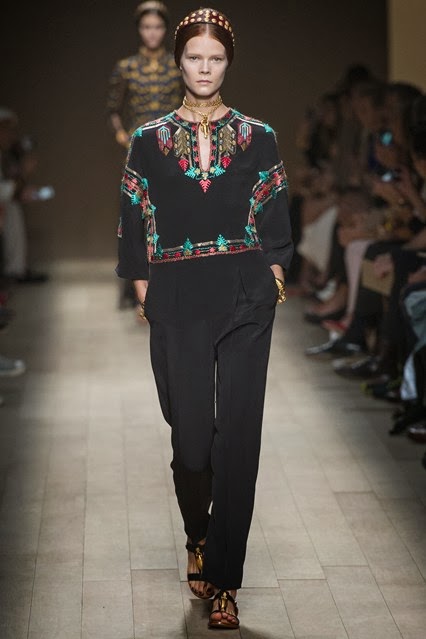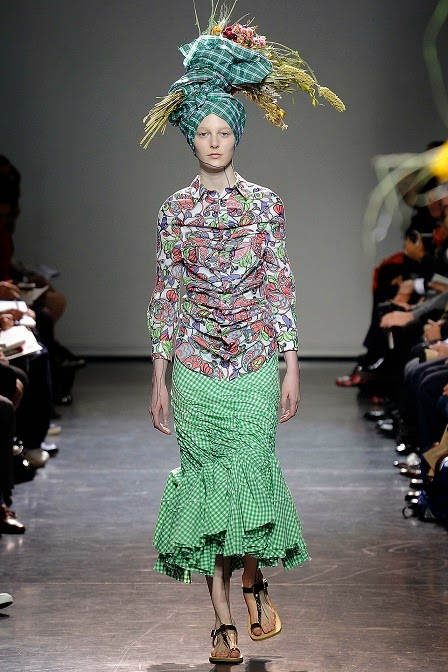Today I would
like to introduce you to extremely talented lady - Gaia Hannan. Knowing her
interests, I believed she is the perfect person to ask about folk and its
influences in her life. I was pleased when she agreed to an interview.
Gaia,
originally from Portland, Oregon, USA, started sewing at a very young age
making clothes and unusual costumes. She studied sewing and fashion design
through school, and at age 18 moved to New York City to study fashion design at
the prestigious Pratt Institute. In 2001 Gaia transferred to Central Saint
Martins in London, England to finish her degree in Performance Design for Theater.
There she continued to focus on making large unusual objects for the stage. At
the moment Gaia works as a Creative
Production Director in Studio Soüfflé
-company that set up and cooperate together with a friend.(Check their great
designs at : http://www.studiosouffle.com/)
I’ve asked her
a series of questions and would like to share the most interesting fragments
with you.
Me: Gaia, can tell me what was
your first memorable contact with folk culture? What was your first impression
of it?
Gaia: When I was about 13 years
old, I saw a movie with some swing dancing in it. I loved the clothes, the
atmosphere and the energy. I had always been into costumes and sewing since I
was very young so I started studying more about the era and what they wore and
why.
Me: Was there anything that especially
captured your attention in folk culture/ fashion? (colors/styling/prints etc ?)
Gaia: The very easy but well
thought through and designed silhouettes, the materials, the fine lines,
attention to detail, quality, femininity, masculinity. The 1930s was a very
important time in history, because it represented the first generation, to
experience the emancipation of women and freedom and so the clothes started to
change and moving into the 40s women's clothes took on a very strong powerful
presence. There was a lot of excitement during this time, because the
government struggled to keep society under control, but the rebels were just
beginning to start the rock'n'roll movement.
Me: I understand your deep interest in folk. Does
it have any influence on your daily life?If yes- how folk influences your life/
activities/ work?
Gaia: My every day style is
influenced by it. My hobbies have turned into work and I often have work
teaching 1930s American style dancing or performing at events.
Me: What about things you create?
Are your designs influenced by folk in any way?
Gaia: When I design
clothes/fashion, there absolutely is a heavy art deco influence. I am always
thinking and dreaming of the day, I can have a house that is completely art
deco, that I can design.
Me: I think we have a common
dream Gaia! Tell me, have you got any favourite
fashion designer, who is influenced by folk art? (or favourite folk
inspirations?)
Gaia: Edith Head was a fantastic
costume designer. She has a wonderful story of how she became a designer and
she has many fantastic tips for other designers.
Me: Folk is very traditional and
rather conservative style. Do you think there is space for folk in fashion in
21st century?
Gaia: Yes, absolutely. I would
categorise it as "cult" and I think it has become very popular now to
dress and act from certain time period. I know a few people who live their
lives by very strict code of conduct, from say, 1937 exactly.... it will be
interesting to see if this trend continues because you have to be a little
crazy dedicated to maintaining the look. Many of the original garments from
these eras can be a lot of work to care for. So I am always impressed with my
friends who show up so immaculately turned out with the perfect hair, make up,
accessories and attitudes, nutters!
Interviewing
Gaia was a great pleasure! Such a creative, talented and simply amazing woman!
Please check out their website (http://www.studiosouffle.com/)
to see their great work!
Coming up: interview with Paulina
Palian – fashion designer and creator of FOLKmania collection!


































.png)








































